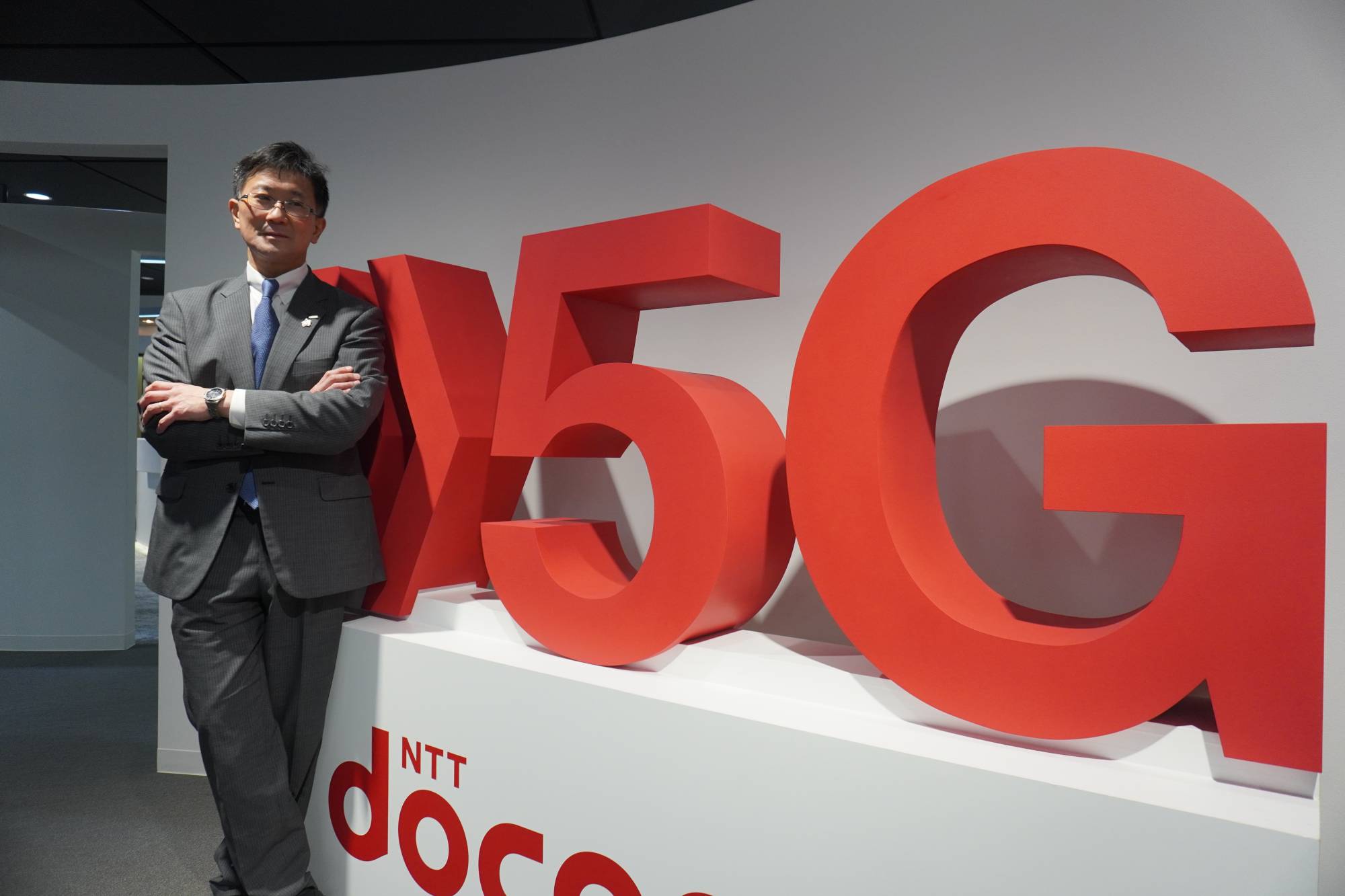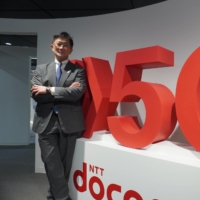At the same time commercial 5G services were launched last March, the world became engulfed in the COVID-19 pandemic, which has changed the lifestyles of many people.
Ironically, however, the pandemic has somehow helped develop digitalization and increased the need for 5G technology to make more remote activities available.
Hisakazu Tsuboya, executive operating officer and general manager of the 5G & IoT Business Department at NTT DOCOMO, spoke with The Japan Times about how 5G technology has developed in Japan over the past year and what it promises to make possible in the near future.
Japan Times: The first commercial 5G service was introduced in Japan in the spring of 2020. To what extent do you think 5G has been accepted?
Hisakazu Tsuboya: NTT DOCOMO launched its next-generation network service on March 25 last year, and the uptake has reached our target in the past year. I can’t give you specific figures, but we are analyzing the outcomes. We are happy about customer responses.
JT: Degrees of acceptance vary by industry and company. To what extent has 5G been put to practical use in such fields as gaming and video? How about factory automation, self-driving vehicles and telemedicine?
Tsuboya: People talk a lot about digital transformation (DX) these days, but if you try to gauge whether companies have achieved digital transformation on a fundamental level, the best you can do to assess where they are is to use the targets set by industry groups or companies. Hospitals, for example, may say telemedicine has fundamentally changed internal functions or made it tremendously easier to manage the high numbers of patients. So if you ask me whether our 5G service has achieved benefits to that level, I have to say yes and no, because it depends on the field where it is being applied and partly because the service is still in its first year.
All things considered, video solutions have grown faster than the control functions provided by our 5G service. We have a significant degree of success in reaching out to areas where remote conferencing is used due to the coronavirus. Factory automation and self-driving vehicles require the use of control functions. These applications don’t only hinge on whether they are 5G or not. There’s also the issue of 5G’s coverage and other associated technologies. So I think DX is an area that will take more time.
JT: The coronavirus pandemic began just as commercial 5G services kicked off. Is this slowing the 5G infrastructure build-out?
Tsuboya: There hasn’t been a significant delay because our teams have been working tirelessly. But we had to put a lot of effort into managing the operations inevitably required in system development for solutions linked to infrastructure and commercial services. Call centers are one example. They create an environment in which our staff has close contact with customers.
JT: Ironically, the coronavirus pandemic has helped some companies and industries speed up digitalization. In your view, how did it affect moves to introduce 5G?
Tsuboya: 5G technology enables high-speed transmission of high-resolution video with minimum latency, so it will create an environment in which people can communicate with others just as in face-to-face conversation. In that sense, it is a technology that transcends time and space. It takes several years for a new communication technology to become widely available. As it becomes more available, devices and equipment that take advantage of it in people’s living environments will come to be used. So it takes time before a technology achieves widespread use. We thought that the benefits of 5G should be considered from a medium- to long-term perspective.
The pandemic came just when 5G was launched. I guess the business possibilities of networks that differ from 3G or 4G will be pursued at an early time and get fleshed out.
JT: The frequency band used for 5G is extremely high and is said to travel only a short distance. That means you have to install a large number of base stations and antennas, doesn’t it?
Tsuboya: In more precise terms, a radio wave in that spectrum travels much further if there’s nothing to block it. As it’s a very high frequency, it is an extremely fine vibration that travels straight without dispersing. So it’s not like it doesn’t travel a long distance. It’s a frequency band that bounces off blocking objects. So in urban areas, it can’t cover many areas unless you set up devices to relay the radio waves in every nook and cranny, including, for example, areas behind buildings.
Radio waves in the 800 megahertz and 2 gigahertz ranges that were used in 4G and 3G networks are relatively good at traveling around objects. These frequency bands can reach spots behind blocking objects, so they were suitable mobile phones.
To achieve the high speed and high bandwidth of 5G, high-frequency bands, such as 28 GHz, had to be used, but because these frequency bands are difficult to handle — not because signals cannot travel very far — it’s important to be creative in using corrective technology and designing coverage areas.
JT: What about the idea of using manhole lids as antennas?
Tsuboya: It’s possible. NTT DOCOMO is working with AGC Inc. to test the idea of using glass as an antenna. Streets are difficult for the 5G network to cover. So you have to think about which street items that can be used to cover them. I think there’s going to be a variety of antennas. Some new ideas have already been put into use.
JT: Some people have warned that power consumption may surge when 5G becomes widespread. What is your view?
Tsuboya: When you send radio waves over a long distance or have a network cover wide areas, or cover wide areas using a small number of base stations, it will naturally consume more power. You could have many base stations in a small area, or you could have a small number of base stations, with each of them sending stronger radio waves. So you have to think carefully about what consumes more energy. As the breadth of frequencies is wider in the 5G network to transmit larger amounts of data, you can’t deny that it requires greater radio wave density and electrical energy.
NTT has proposed a new network and information processing infrastructure called IOWN (Innovative Optical and Wireless Network) that achieves higher transmission speeds and reduced power consumption. Radio waves are converted into light and sent through fiber-optic cables, converted into electricity at the switchboard and again converted back to light. The conversion between light and electricity makes a network inefficient.
The idea of creating an “All Photonics Network,” which is a key technology area of IOWN, is to eliminate the need for this conversion. It is a very important, highly energy-efficient way of designing a network infrastructure that NTT should work on. It will also help achieve the (U.N.) sustainable development goals and reduce power consumption.
JT: NTT DOCOMO has worked with companies in other industries to test out 5G. For example, it worked with Sompo Holdings Inc. in the health care and nursing care fields, H2L Inc. in virtual reality tourism and Sun Corp. in remote work support solutions. What are the areas you are focusing on?
Tsuboya: We’ve done beta releases of services based on various hypotheses and more than a year in have conducted over 500 test projects on commercial services. These tests are still underway while we work to develop the laboratory. We are discussing various subjects with over 3,600 companies in the “DOCOMO 5G Open Partner Program.” In terms of a match between seeds held by the creating side and the needs held by the receiving side, video solutions have led all other fields in the past year.
Remote medical treatment and self-driving are regarded as mission-critical technologies. We have tested operations involving a real-time technology that can achieve very difficult things that in the past have put people’s lives at risk, and we have tested the quality of transmission. If you want to encourage wide-ranging industries to introduce 5G, you just have to conduct discussions and present proof of concept, again and again.
JT: Commercial 5G services have just kicked off, but people are already talking about “Beyond 5G.” What is NTT DOCOMO doing to prepare for it?
Tsuboya: Last year, NTT DOCOMO released a white paper on (Beyond 5G). Our research and development division is working to determine which frequency bands should be used and the best wireless transmission format. So we are going to use data from such efforts to conduct more research and development.
The NTT Group is making efforts to develop new types of network and information processing infrastructure, including those using fiber-optic technology, and new processor devices to support them, on an ongoing basis. I hope we will produce innovations that reflect the pride of the NTT Group.




